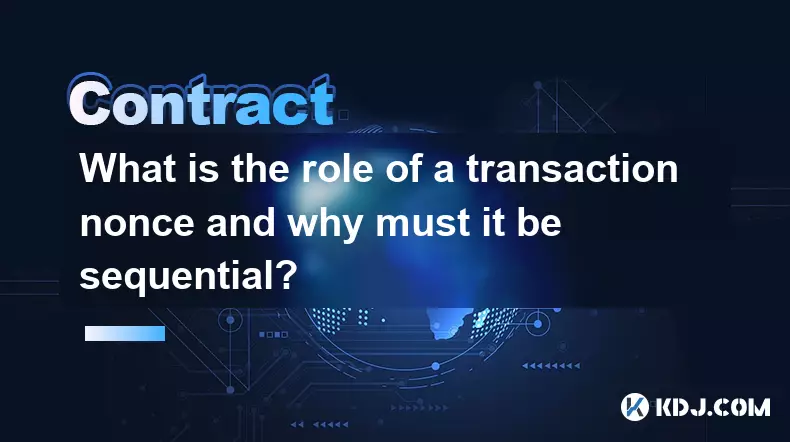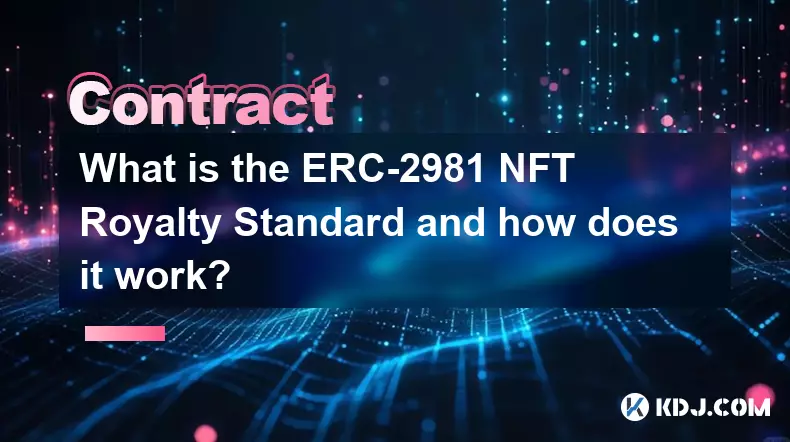-
 bitcoin
bitcoin $102182.982207 USD
-0.92% -
 ethereum
ethereum $3438.744518 USD
0.12% -
 tether
tether $0.999933 USD
0.02% -
 xrp
xrp $2.405093 USD
0.05% -
 bnb
bnb $956.306114 USD
-0.53% -
 solana
solana $153.028851 USD
-1.23% -
 usd-coin
usd-coin $0.999800 USD
-0.03% -
 tron
tron $0.294898 USD
-1.08% -
 dogecoin
dogecoin $0.171428 USD
-0.58% -
 cardano
cardano $0.551186 USD
-1.15% -
 hyperliquid
hyperliquid $38.755878 USD
0.04% -
 chainlink
chainlink $15.298460 USD
-0.05% -
 bitcoin-cash
bitcoin-cash $516.067428 USD
1.68% -
 stellar
stellar $0.280726 USD
-0.42% -
 zcash
zcash $518.919369 USD
18.01%
What is the role of a transaction nonce and why must it be sequential?
A transaction nonce ensures unique, ordered transactions in account-based blockchains like Ethereum, preventing replay attacks and maintaining state integrity.
Nov 09, 2025 at 01:00 am

Understanding the Transaction Nonce in Blockchain Systems
1. A transaction nonce is a number used once, associated with a user's account in blockchain networks like Ethereum. It represents the count of transactions sent from a specific address. Every time a new transaction originates from an account, the nonce increases by one, ensuring each transaction can be uniquely identified.
2. The primary role of the nonce is to prevent replay attacks. Without a nonce, a signed transaction could be re-broadcasted multiple times, leading to unintended duplicate transfers. By requiring each transaction to carry a unique, incrementing number, the network ensures that even if a transaction is intercepted and rebroadcasted, it will be rejected if the nonce has already been processed.
3. The nonce also helps maintain transaction order when multiple operations are initiated from the same wallet. In decentralized systems where miners or validators process transactions asynchronously, there’s no guarantee of execution order based solely on arrival time. The sequential nature of the nonce enforces a predictable sequence, allowing wallets and nodes to queue transactions properly.
4. Wallet software relies on nonces to manage pending transactions. If a user sends several transactions in rapid succession, each must have a sequentially increasing nonce. This allows clients to track which transactions are confirmed and which remain pending, avoiding confusion during periods of network congestion.
5. The nonce is critical for account-based blockchain models where state changes depend on ordered interactions. Without a strictly sequential nonce, the integrity of the account’s transaction history would be compromised, potentially enabling double-spends or inconsistent states.
Why Sequentiality Is Mandatory
1. Blockchain nodes validate transactions before including them in blocks. One of the checks performed is whether the transaction’s nonce matches the expected value—the current nonce of the sender’s account plus one. If a transaction carries a nonce that is too low, it is deemed invalid because it likely duplicates a prior action.
2. If a transaction has a nonce that is too high, nodes will reject it or place it in a mempool as pending, waiting for the missing intermediate nonces to arrive. This prevents gaps in the sequence, ensuring no future transaction can leapfrog ahead and disrupt logical execution flow.
3. Sequential nonces enforce deterministic processing. Even if five transactions are broadcast out of order, the network will only execute them in the correct numerical sequence, preserving the intended state transitions across the ledger.
4. This mechanism protects against front-running attempts where malicious actors might try to reorder transactions for profit. While MEV (Miner Extractable Value) still exists, the nonce constraint limits arbitrary reordering by external parties.
5. Smart contract interactions often depend on precise operation sequences. For example, approving a token spend before executing a swap requires two separate transactions. A non-sequential nonce could cause the second transaction to fail, freezing funds or triggering unexpected behaviors in dApps.
Handling Nonce Management in Practice
1. Most modern cryptocurrency wallets automatically track and assign nonces. When a user initiates a transaction, the wallet queries the network for the current nonce and increments it accordingly. This minimizes user error and ensures smooth submission.
2. In cases where a transaction remains stuck due to low gas fees, users may choose to replace it using the same nonce but with higher fees—a practice known as “speeding up” a transaction. This works because a new transaction with the same nonce and higher fee will invalidate the previous one once confirmed.
3. Advanced users or developers interacting directly with RPC endpoints must manually manage nonces. Failure to do so—such as reusing a nonce or skipping a number—results in rejected transactions, wasted gas, or prolonged delays.
4. Some wallet interfaces allow 'canceling' a pending transaction by sending another with the same nonce but zero value and higher gas. This effectively overwrites the original operation, freeing up the account state for subsequent actions.
5. Mismanaged nonces are a common source of failed transactions in automated trading bots and DeFi scripts. Ensuring strict incrementation and synchronization across distributed systems is essential for reliability.
Frequently Asked Questions
What happens if I reuse a transaction nonce?Reusing a nonce results in one of two outcomes: if the original transaction was confirmed, the duplicate is immediately rejected. If the original is still pending, the newer transaction may replace it—provided it offers higher gas fees—but this behavior depends on node policies and timing.
Can I skip a nonce value to prioritize a transaction?No. Skipping a nonce creates a gap that prevents any subsequent transaction from being processed. Nodes will not accept a transaction with a nonce higher than the current account nonce plus one, regardless of gas price or urgency.
How do I check my current nonce?You can retrieve your current nonce via blockchain explorers or by calling the JSON-RPC method eth_getTransactionCount, specifying your address and the block state (e.g., 'pending') to include unconfirmed transactions.
Do all blockchains use transaction nonces?Not all. UTXO-based blockchains like Bitcoin do not use nonces in the same way. Instead, they rely on input references to prevent double-spending. Nonces are primarily used in account-based models such as Ethereum, Binance Smart Chain, and Polygon.
Disclaimer:info@kdj.com
The information provided is not trading advice. kdj.com does not assume any responsibility for any investments made based on the information provided in this article. Cryptocurrencies are highly volatile and it is highly recommended that you invest with caution after thorough research!
If you believe that the content used on this website infringes your copyright, please contact us immediately (info@kdj.com) and we will delete it promptly.
- Token Listing Mania: Attention Turns to BANK, MET, and the Rise of Meme Coin Utility
- 2025-11-14 01:00:01
- ZEC, Zcash, and Winklevoss: A New Chapter for Privacy?
- 2025-11-14 01:50:01
- Pi Network's Web3 Gaming Ecosystem: A New Dawn or Just Hype?
- 2025-11-14 01:20:01
- Decoding the Crypto Buzz: From SocialFi to Meme Coins, What's Worth Watching?
- 2025-11-14 01:30:02
- Hashgraph, Tokenization, and Hedera (HBAR): A New Era for Real-World Assets?
- 2025-11-14 01:10:02
- Lorenzo Protocol, Meteora Tokens, and Binance Listing: A New Era for Solana DeFi?
- 2025-11-14 01:35:01
Related knowledge

What is a Denial of Service (DoS) attack in a smart contract and what are its common forms?
Nov 10,2025 at 05:20am
Understanding Denial of Service in Smart Contracts1. A Denial of Service (DoS) attack in the context of smart contracts refers to a scenario where a m...

What is a cryptographic nonce used for in transaction signing?
Nov 11,2025 at 05:59am
Understanding Cryptographic Nonces in Blockchain Transactions1. A cryptographic nonce is a random or pseudo-random number used only once in the contex...

How does inheritance work in Solidity smart contracts?
Nov 11,2025 at 10:40pm
Inheritance in Solidity: Building Modular Smart Contracts1. Inheritance in Solidity allows one contract to adopt the properties and functions of anoth...

What is the difference between an Externally Owned Account (EOA) and a Contract Account?
Nov 13,2025 at 04:00am
Understanding Externally Owned Accounts (EOA)1. An Externally Owned Account is controlled directly by a private key, which means only the holder of th...

What is the ERC-2981 NFT Royalty Standard and how does it work?
Nov 13,2025 at 05:39am
Understanding the ERC-2981 NFT Royalty Standard1. The ERC-2981 standard is a proposed Ethereum Request for Comment that introduces a royalty mechanism...

What is a Minimal Proxy Contract (EIP-1167) and how does it save gas on deployment?
Nov 12,2025 at 11:39am
What is a Minimal Proxy Contract (EIP-1167)?1. A Minimal Proxy Contract, standardized under Ethereum Improvement Proposal (EIP) 1167, is a lightweight...

What is a Denial of Service (DoS) attack in a smart contract and what are its common forms?
Nov 10,2025 at 05:20am
Understanding Denial of Service in Smart Contracts1. A Denial of Service (DoS) attack in the context of smart contracts refers to a scenario where a m...

What is a cryptographic nonce used for in transaction signing?
Nov 11,2025 at 05:59am
Understanding Cryptographic Nonces in Blockchain Transactions1. A cryptographic nonce is a random or pseudo-random number used only once in the contex...

How does inheritance work in Solidity smart contracts?
Nov 11,2025 at 10:40pm
Inheritance in Solidity: Building Modular Smart Contracts1. Inheritance in Solidity allows one contract to adopt the properties and functions of anoth...

What is the difference between an Externally Owned Account (EOA) and a Contract Account?
Nov 13,2025 at 04:00am
Understanding Externally Owned Accounts (EOA)1. An Externally Owned Account is controlled directly by a private key, which means only the holder of th...

What is the ERC-2981 NFT Royalty Standard and how does it work?
Nov 13,2025 at 05:39am
Understanding the ERC-2981 NFT Royalty Standard1. The ERC-2981 standard is a proposed Ethereum Request for Comment that introduces a royalty mechanism...

What is a Minimal Proxy Contract (EIP-1167) and how does it save gas on deployment?
Nov 12,2025 at 11:39am
What is a Minimal Proxy Contract (EIP-1167)?1. A Minimal Proxy Contract, standardized under Ethereum Improvement Proposal (EIP) 1167, is a lightweight...
See all articles










































































